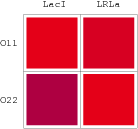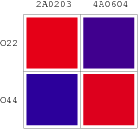USTC/Interference between LacI and LRLa
From 2007.igem.org
According to the in vitro cross-binding data reported by Kalodimos et al. [1], We used [http://partsregistry.org/Part:BBa_I732100 LacI] and [http://partsregistry.org/Part:BBa_I732101 LRLa] as the upstream input signals in the first version co-repression test-bench, and used O11 (the symmetric operator of [http://partsregistry.org/Part:BBa_I732100 LacI]) and O22(the symmetric operator of [http://partsregistry.org/Part:BBa_I732101 LRLa]) to construct logic promoters such as [http://partsregistry.org/Part:BBa_I732352 BBa_I732352]. But unfortunately, experimental data show that these two repressor can bind to the relative operator of each other in vivo. All measurements of co-repression based-on these two repressors are abandoned. The combination of [http://partsregistry.org/Part:BBa_I732100 LacI] and [http://partsregistry.org/partsdb/view.cgi?part_id=9753 ARL2A0203] are replaced with [http://partsregistry.org/partsdb/view.cgi?part_id=9758 ARL4A0604] in the later experiments.
References
- Kalodimos, C. G.; Bonvin, A. M. J. J.; Salinas, R. K.; Wechselberger, R.; Boelens, R. & Kaptein, R. (2002), 'Plasticity in protein-DNA recognition: lac repressor interacts with its natural operator 01 through alternative conformations of its DNA-binding domain.', EMBO J 21(12), 2866--2876.

